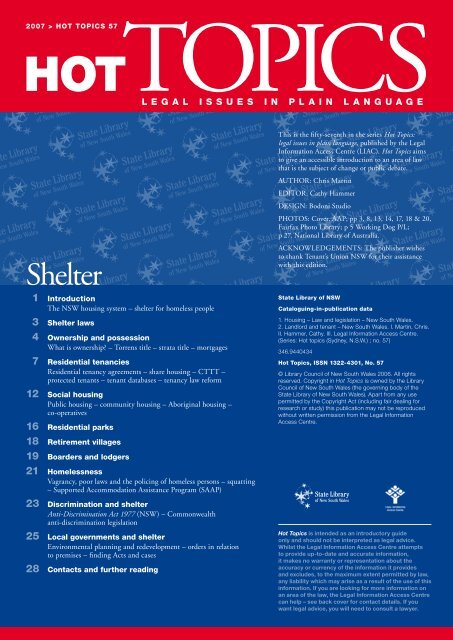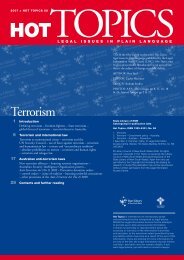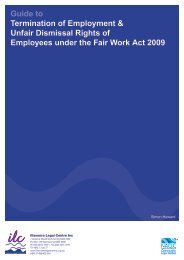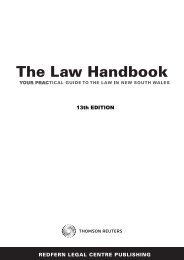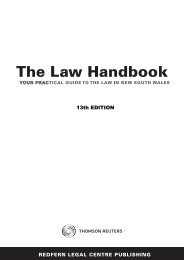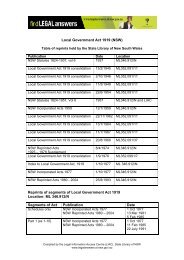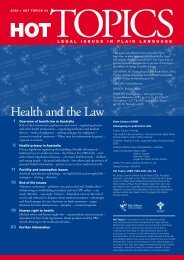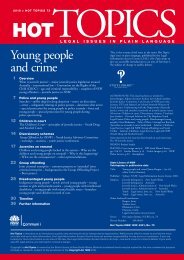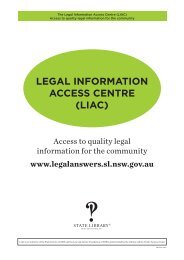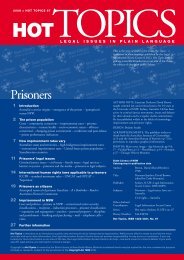Shelter - Hot Topics 57 - Legal Information Access Centre - NSW ...
Shelter - Hot Topics 57 - Legal Information Access Centre - NSW ...
Shelter - Hot Topics 57 - Legal Information Access Centre - NSW ...
- No tags were found...
Create successful ePaper yourself
Turn your PDF publications into a flip-book with our unique Google optimized e-Paper software.
Introductionshelter is a basic human need. a person’sphysical and emotional wellbeing depends onit; so does the organisation of family life andmost other forms of social activity, like work andeducation. shelter is the dominant purpose of ourbuilt environment. it is also a major expense andan asset – for most households, housing is themost significant means of saving and investing.it is an important concern of governments, whichregulate, directly and indirectly, the supply,quality, cost and security of shelter, and whogets what out of it. For all these reasons, shelteris also significant legally.Figure 2: housing sectors – australian statesand territories100%90%80%70%60%50%40%30%20%10%0%<strong>NSW</strong> VIC QLD SA WA TAS NT ACT AUSTOwner-occupied (with and without a mortgage)THe <strong>NSW</strong> HOuSiNg SySTemThere are more than 2.5 million households in NewSouth Wales. Owner-occupied housing is the mostcommon form of shelter in New South Wales – a totalof almost 70 per cent of households own their housing– but a large minority of the population rents.Figure 1: nsW households, by housing sector23%5%34%2%Source: ABS (2006).36%Owner without amortgageOwner with a mortgagePrivate renterPublic housing tenantOther rentersThe proportions of the different sectors of the housingsystem are fairly similar across Australia. When we lookat the housing systems of other industrialised countries,as in figure 3, the New South Wales housing systemis distinctive mostly because of the high proportion ofowner-occupied housing, and the low proportion ofsocial housing.New South WalesUnited StatesPrivate rentalPublic housingSource: ABS, 2006.Figure 3: housing sectors – an internationalcomparison100%90%80%70%60%50%40%30%20%10%0%New ZealandCanadaBelgiumIrelandDenmarkEnglandFranceGermanyNetherlandsOwner-occupied Private rental Social housingSwedenNote: figures 1 and 2 refer to ‘public housing’, and figure 3 refersto ‘social housing.’ The distinction is explained in section on ‘socialhousing’.Source: T Burke & L Ralston (2003) Analysis of the expenditurepatterns and levels of household indebtedness in public and privatehousing, 1975-1999, AHURI, Melbourne.OWNer-Occupied HOuSiNgIn New South Wales, about 1.75 million householdsown the housing in which they live. About half ownsubject to a mortgage.introduction 1
<strong>Shelter</strong> lawsthere is no single area of the law that deals withshelter. Rather, the law relating to shelter isspread across a number of different areas of thelaw, each of which comprises common law andstatutory law. all of the following, for example,can be included in the ‘laws of shelter’.THe laW Of real prOperTyThere are legal interests that arise from the possessionof land, including housing. The most prominent ofthese interests is ownership, and much of the law of realproperty is concerned with theHOT Tipprotection of an owner’s right topossession of a property and thein general terms ‘realways in which ownership canproperty’ refers to landand what is attached be transferred to other parties.to land, as opposed topersonal property.cONTracT laWThe law also recognises otherinterests in land, such as leasesand mortgages.Contract law is especially important in relation to rentalhousing. A lease, for example, results in an ongoingcontractual obligation between landlord and tenant, aswell as an interest in the land. Some rights to occupyproperty are entirely contractual: these contracts arecalled ‘licences.’ The common law of contract hasundergone a great deal of statutory amendment, muchof which can be characterised as consumer protectionlaw. Principles of consumer protection can be seen inthe Residential Tenancies Act 1987, the most importantpiece of legislation for residential landlords and tenantsin New South Wales.admiNiSTraTive laWThe decisions of government agencies, including the <strong>NSW</strong>Department of Housing are subject to administrative law.As well as being subject to the Residential Tenancies Act1987, the Department’s decisions in relation to its tenantsmust also comply with the principles of proceduralfairness and other administrative law principles. TheConsumer, Trader and Tenancy Tribunal (CTTT),which is the major forum for resolution of disputesabout housing in New South Wales, is also subject tothe principles of procedural fairness, as modified by theConsumer, Trader and Tenancy Tribunal Act 2001.HumaN rigHTSA number of important sources of human rights, suchas the United Nations’ Universal Declaration of HumanRights (1948) and the International Covenant on Economic,Social and Cultural Rights (1968), expressly refer tohousing. 8 In <strong>NSW</strong> and other Australian jurisdictions,probably the most direct application of human rights tothe law of shelter is through anti-discrimination law.THe builT eNvirONmeNTThere are a wide range of Acts and other types oflegal instruments that regulate the built environment,including housing. In particular, local governmentorders in relation to housing, and the planning processin relation to redevelopments.crimiNal laWThe laws relating to police powers are relevant in thatthey have special impacts on people who are withoutshelter.It is also important to acknowledge the vast and complexlegal regimes that support and shape economic processes,such as tax laws, and their effect on shelter. These typesof laws do not prescribe individuals’ legal rights inrelation to shelter in the same direct way as, say, a leaseunder the Residential Tenancies Act 1987, but their effecton the accessibility, cost, quality and security of theshelter delivered by the housing system generally is atleast as strong.image u navailablePhillip Coperburg was bashed by a gang of young menin an attack on homeless people outside the MatthewTalbot Men’s Refuge in Sydney 2003.Jacky Ghossein, SMH.8. See UN Fact Sheet No. 21, The Human Right to Adequate Housing available at www.unhchr.ch/htm/menu6/2/fs21.htm.shelter laws 3
WHaT iS OWNerSHip?<strong>Legal</strong>ly speaking, a person who owns a house may be saidto own ‘freehold’ or to ‘hold the land of the Crown in theright of the State (New South Wales).’ Alternatively, theymay be said to hold ‘an estate in fee simple.’ Alternativelyagain, they may be said to have ‘title’ in relation to theproperty. What do these things mean?The first two formulations come from real propertylaw’s roots in feudal English law. In the Middle Ages,possession of land was held by arrangement with the localfeudal lord, who in turn held their lands from anothersuperior lord and, ultimately, from the King. The termson which persons held land – that is, their ‘tenure’ (fromthe Latin ‘tenere’, meaning ‘to hold’) – varied, and rangedfrom performing military services for the lord (‘knightservice’), religious services (‘frankalmoin’) to variousagricultural duties (‘free and common socage’). Overthe centuries, the value of these services diminished, theintermediary lords dropped out of the relation betweenland holder and the King, and the Tenures Abolition Act1660 converted all tenures to free and common socageand abolished the remaining incidental duties of thetenure. New South Wales, of course, never had feudallords, but imported the doctrine of tenure with the restof English law. Today, the tenure of free and commonsocage is generally referred to as ‘freehold,’ and the lawstill recognises that, at least theoretically, the land is held‘of the Crown.’The formulation ‘estate in fee simple’ also comes fromthe feudal roots of real property law. The legal right thattenure invested in a landholder was called an ‘estate.’ Aperson did not own the land itself so much as their estatein the land, and the estate is the thing that entitled themto possession. In the face of the permanence of land,the law devised estates of different duration, and thereremain two freehold estates under the law of New SouthWales today. The most common is the ‘estate in feesimple,’ which the holder can dispose of while they arestill alive, or pass on to any of their heirs after death, andwhich is most associated with ‘ownership’ of property.The other is the ‘life estate’, which lasts as long as theholder is alive, and cannot be passed on after death. Bothentitle the holder to possession of the land, but the feesimple is said to be the ‘larger’ of the two estates, becausea person holding an estate in fee simple can grant anotherperson a life estate in relation to the property, but notvice versa. Where the holder of a fee simple grants alife estate, they also create another legal interest (eithera ‘reversion’ or a ‘remainder’) that returns the right ofpossession when the life estate ends.image u navailableThe Kerrigan family from the movie the castle, who defend the principle tht ‘a man’s home is his castle’,(1997) Working Dog Pty Ltd.ownership and possession 5
termination and evictionSection 53 of the RT Act sets out the circumstances inwhich a tenancy agreement is terminated. Most tenancyagreements are terminated when one party (usually thetenant) gives the other party a notice of termination,and the tenant moves out. The period of notice requireddepends on which party is giving the notice, and thegrounds (if any) for the notice:notice given bygroundsperiodrequiredtenant end of fixed term 14 dayslandlord’s breachfrustration (premisesuninhabitable)no grounds (continuingagreements only)14 daysimmediate21 daysLandlord end of fixed term 14 daystenant’s breachfrustration (premisesuninhabitable)sale of premises (continuingagreements only)no grounds (continuingagreements only)14 daysimmediate30 days60 daysThe RT Act also sets out requirements relating to thecontent and service of termination notices. Notices maybe served by post, but four working days must be addedfor postage (s 76 of the Interpretation Act 1987).Giving a notice of termination does not, by itself,terminate a tenancy. If a tenant remains in the premisesafter the date given in a notice of termination, thetenancy remains on foot, and if the landlord wants toevict the tenant (that is, force the tenant to move out),the landlord must apply to the CTTT for an orderterminating the tenancy and returning possession to thelandlord. The Tribunal will hear from both parties asto whether the tenancy should be terminated and, if so,when the tenant should be required to move out. Unders 64 of the RT Act the Tribunal must consider ‘thecircumstances of the case’.In circumstances where continuing an agreement wouldcause undue hardship to the landlord or the tenant(s 69); or where the tenant has caused, or is likely tocause, serious damage to the premises or injury to thelandlord (s 68), a party can apply to the CTTT for anorder terminating a tenancy without first giving a noticeof termination.caSe STudyin Roads and Traffic Authority of <strong>NSW</strong> v Swain, the court ofappeal considered the words ‘circumstances of the case’and held that they meant that the tribunal had a discretionto decline to make termination orders, particularly wherethe tenant would suffer hardship if the tenancy wasterminated. Following the swain litigation, the tribunalhas considered a number of factors as being relevant‘circumstances’, including the length of the tenancy, theage and health of the tenant, the tenant’s employment,the tenant’s social contacts in an area, and whetherthe landlord requires the premises for another person’shousing (Adavale Realty Pty Ltd v Williams).the decisions are available online through austLii:Roads and Traffic Authority of <strong>NSW</strong> v Swain (1997) 41nsWLR 452; www.austlii.edu.au/au/cases/nsw/supreme_ct/95040165.htmlAdavale Realty Pty Ltd v Williams Rtt 96/02133;www.austlii.edu.au/au/cases/nsw/nsWRt/1996/190.htmlSection 72 of the RT Act deals with unlawful evictions(sometimes called ‘lockouts’). Under s 72(1), it isan offence to enter premises to evict a tenant orformer tenant except by order of the CTTT or acourt: the penalty for this offence is a fine up to$22 000. Where the CTTT has made an order returningpossession to the landlord, and the tenant remains inpossession, section 73(1) provides that the Tribunalmay issue an enforceable order (a ‘warrant’) to the<strong>NSW</strong> Sheriff, who may use reasonable force (includingassistance for the police) to evict the tenant and recoverpossession. A landlord is not allowed to personally carryout an eviction.SHare HOuSiNgShare housing is a common way of renting, especiallyfor younger people. Depending on the circumstances,the legal relationship between people who share rentalhousing may be that of:> co-tenants – the housemates are jointly and severallyliable: that is, the landlord may hold any one co-tenantliable for the whole of the agreement;> subtenant and head-tenant – one of the housematesis a tenant of another housemate. In law, this is atenant-landlord relationship with all the rights andobligations of a residential tenancy agreement;> lodger and head-tenant – one of the housemates is alodger of another housemate. This is a lodger-landlordrelationship, as discussed in the chapter on boardersand lodgers at page 19.Large share households may include a combination ofthese relationships.Residential tenancies 9
A common problem in share housing arises where oneco-tenant moves out of the premises, and the other cotenantsremain – often with a new housemate to replacethe departing co-tenant. In many cases, the departingco-tenant remains liable to the landlord under theresidential tenancy agreement, including for arrears anddamage incurred after they left. There are a number ofways to end the liability of the departing co-tenant. Oneis for the remaining housemates and the landlord to enterinto a new tenancy agreement. Otherwise, the departingco-tenant can assign their interest in the tenancy to theremaining co-tenants or the in-coming housemate, whoin turn indemnify the departing co-tenant against anyliability. Assignment must be done in a particular legalform (a ‘deed’). Each of these arrangements, however,requires the consent of all parties, including the landlord– without it, the departing co-tenant’s best option is toapply to the CTTT for an order terminating the tenancyon the ground of hardship (s 69A).THe cONSumer, Trader aNdTeNaNcy TribuNalThe CTTT was established by the Consumer, Trader andTenancy Tribunal Act 2001 (CTTT Act). The CTTThas eight divisions including Tenancy, ResidentialParks, Retirement Villages, and Strata and CommunitySchemes.The objects of the CTTT Act include ‘to enableproceedings to be determined in an informal, expeditiousand inexpensive manner’ (s 3(c)). The Tribunal is not acourt – its proceedings are similar, but less formal.For example, Tribunal members do not wear wigs andgowns, and are not addressed as ‘Your Honour’ they justuse their names, or ‘Chairperson’. Most parties appearingbefore the Tribunal represent themselves, and lawyersmay appear only in limited circumstances (althoughlandlords may be represented by their real estate agentand tenants may, with the Tribunal’s leave, be representedby an advocate). The Tribunal is not bound by the rulesof evidence: section 28(2). It does, however, make ordersthat are legally binding on parties.The Tribunal has a statutory obligation to conduct itsproceedings according to the rules of procedural fairness(s 28(2)). These rules are from the common law, and canbe summarised as follows:> the hearing rule: the Tribunal should give eachparty to a dispute an opportunity to state their casebefore it makes a determination, and should alloweach party to comment on any information adverse totheir case;> the bias rule: the Tribunal, in making adetermination, should not have a preconceivedopinion or a personal interest in the outcome of thedetermination;> the evidence rule: the Tribunal should makedeterminations only on the basis of reasonableevidence.The CTTT Act (section 68(2)) also provides that partiesmay request a rehearing if they may have suffered asubstantial injustice because, for example, new evidencehas arisen.Under section 67 of the CTTT Act, a party whobelieves that the Tribunal has made an error of law in adetermination may appeal to the Supreme Court.reNT cONTrOl aNd ‘prOTecTedTeNaNTS’Many people are aware of the term ‘rent control’ frompopular culture, especially American television shows.Many people are not aware that New South Wales hashad different forms of rent control legislation since beforethe Second World War, and a few tenancies remaincovered by rent control and related protections today.These tenancies are often called ‘protected tenancies.’The most important piece of rent control legislation isthe Landlord and Tenant (Amendment) Act 1948. Theprovisions of this Act reflect a desire by governmentsto control prices during the war and post-war periods,rather than principles of consumer protection. So, theAct provides significant protections against rent increasesand evictions. Rents can be limited to well below themarket rent, and the grounds for terminating tenanciesare very limited. On the other hand, the Act makes noprovision for tenants’ rights in relations to repairs andmaintenance.The Landlord and Tenant (Amendment) Act 1948 appliesto particular classes of premises (defined by the date ofconstruction, and whether certain types of leases wereever registered in relation to them). Amending legislationin the 1950s and 1960s curtailed the operation of theAct, and as new tenancies commenced many premiseswere removed from its application. No new protectedtenancies have been created since 1 January 1986(though existing protected tenancies may, in certainlimited circumstances, be inherited by a protectedtenant’s heirs: s 83A).Protected tenancies are often fraught relationships.When premises subject to the Landlord and Tenant(Amendment) Act 1948 are sold, the purchaser usuallyreceives a discount because of the restrictions of theAct: these landlords can make a windfall if the tenantmoves out. On the other hand, protected tenants arealmost always elderly and have spent many years intheir premises, and are greatly attached to their homes.Protected tenants must be vigilant against unscrupulouslandlords seeking to end their tenancies without a fairsettlement.10HOT TOPICS <strong>57</strong> > <strong>Shelter</strong>
TeNaNT daTabaSeSSometimes known as ‘bad tenant databases’ or ‘blacklists’,tenant databases compile personal information abouttenants and applicants collected by their members(mostly real estate agents). The tenant database makesthis information available to all its members, particularlyso that the member can check an applicant for a tenancyagainst the information recorded in the database. Thereare a number of tenant databases operating in NewSouth Wales, and all are private companies.Tenant database operators and real estate agents claimthat tenant databases are a valid risk management toolfor landlords’ agents. Tenant advocates, on the otherhand, argue that tenant databases do not have a validplace in the rental housing system. They say that riskmanagement is better done through checking applicants’references and managing tenancies diligently. They alsopoint to the drastic effect that being listed can have ona person: it can effectively exclude them from rentalhousing and make them homeless.In New South Wales there are two legislative regimesrelating to tenant databases. First is the CommonwealthPrivacy Act 1988 (Cth), which applies through Australia,and in particular the private sector amendments thatcommenced operation in 2002. These amendmentsinclude the National Privacy Principles (NPPs), whichset out requirements for organisations that collectinformation. These include that methods be ‘lawful andfair’, and taking reasonable steps to ensure the personknows information has been collected, and that theinformation is accurate.The Privacy Act 1988 is administered by the Office of theFederal Privacy Commissioner who, among other things,investigates complaints in relation to the NPPs.The second regime is the rule of conduct for real estateagents in the Property, Stock and Business Agents Regulation2003. The circumstances in which an agent may list aperson on a tenant database are set out in Schedule 6A(clause 4(1)). They require there to have been a reasonsuch as serious property damage or money owing, andfor the person to have been given the opportunity torespond to the proposed listing.The rule also provides that agents may only use tenantdatabases that comply with certain standards as set outin Schedule 6A (clause 6).There are a number of problems with the rule. First, itcovers only agents, not private landlords, park operatorsor boarding house owners – or, for that matter, tenantdatabase operators, who can, apparently, list individualsin their own right. Second, the standards for tenantdatabase operators assume that tenant database operatorswill include the reason for a listing in the informationon the database. TICA is currently exploiting thisTica aNd THe Privacy act 1988in 2004, the tenants’ union of Queensland brought arepresentative complaint against the tenant databaseoperator tica for breach of the npps. after aninvestigation, the privacy commissioner determined thattica’s practices breached the npps on 13 separate counts,including that it unlawfully failed to ensure that informationon its databases was accurate, complete and up to date,and that it had charged unlawful fees for access toinformation. tica has had to change its unlawful practices,particularly to allow individuals to enquire, without charge,as to whether they are listed, and to allow access toinformation upon payment of a reasonable charge only (theprivacy commissioner indicated that $32 was the maximumreasonable amount). tica may be liable to compensatepersons who incurred losses as a result of its breaches ofthe npps.however, the privacy commissioner also determined that,except in a few instances, he did not have the powerto make orders specifying how tica is to conduct itsoperations in a way that is consistent with the npps.instead, the privacy commissioner made a series ofrecommendations, including that tica only list people forparticular reasons and for particular time frames. Recently,tica appears to have disregarded these recommendations,and has commenced listing persons without reference toreasons at all.to view case notes and determinations of the Federalprivacy commissioner go to http://www.privacy.gov.au/act/casenotes/index.htmlloophole by not referring to reasons. Third, there is nostraightforward mechanism for resolving disputes: if aperson has a complaint about an agent’s conduct, theycan only provide the information to the <strong>NSW</strong> Officeof Fair Trading for an investigation. If they have acomplaint about a tenant database operator, they musttry to frame their complaint as a complaint against anagent – which may be impossible.TeNaNcy laW refOrmIn 2005, the <strong>NSW</strong> Office of Fair Trading commenceda review of the Residential Tenancies Act 1987, inpreparation for what may be the first comprehensivereform of New South Wales residential tenancy law inalmost 20 years. Some options raised by the Office ofFair Trading included long term leases with a fixed termof 10 years that would allow the parties to contract outof the usual terms of the Residential Tenancies Act 1987,and amendments removing the Tribunal’s discretion todecline to make termination orders where the tenant hasgiven a notice without grounds.Tenants’ advocates have made different recommendationsfor law reform which are available from the Office of FairTrading website www.fairtrading.nsw.gov.au.Residential tenancies 11
Social housingSocial housing in New South Wales comprises the following types of housing:> public housing;> community housing;> Aboriginal housing;> co-operative housing.The first public housing in New South Wales came aboutalmost accidentally, when the government resumed largeparts of the Rocks, including workers’ housing, followingan outbreak of bubonic plague in 1901. A few more orless ad hoc public housing projects were commencedbefore the Second World War, but it was really with theestablishment of the Housing Commission in 1942 that<strong>NSW</strong> commenced a substantial, albeit relatively small,social housing sector. The other parts of the sector arosein the 1970s and 1980s to complement the housingprovided by the Housing Commission and its successor,the Department of Housing.Almost all social housing tenants are covered by theResidential Tenancies Act 1987 (there are only a very fewexceptions, such as residents of boarding houses operatedby social housing landlords). In most respects, socialhousing tenants have the same rights and obligations astenants of private rental housing.The Residential Tenancies Act 1987 does, however, makesome provisions that are specific to social housing. Notall of these special provisions apply to all types of socialhousing. This is because these special provisions usedifferent terms – ‘social housing provider’, ‘social housingpremises’, ‘social housing tenancy agreement’ and ‘publichousing agreement’ – and these terms are not equivalent.In particular, for the purposes of the Residential TenanciesAct 1987 not all ‘social housing providers’ enter into‘social housing tenancy agreements.’Some aspects of social housing – such as decisions abouteligibility, allocations, rent subsidies and transfers – arenot dealt with by the Residential Tenancies Act 1987 orthe Consumer, Trader and Tenancy Tribunal. Thesesorts of matters may be dealt with through the landlord’sown procedures for reviewing decisions, and by theHousing Appeals Committee.public HOuSiNgThe <strong>NSW</strong> Department of Housing dominates therelatively small social housing sector in <strong>NSW</strong> (theDepartment is actually one of the largest social housingproviders in the English-speaking world – a big fish in asmall pond). As well as being the largest landlord, it isalso the main source of funding and the main regulatorfor the other social housing landlords.reSHapiNg public HOuSiNg: TargeTiNg aNd TempOrary TeNurein april 2005, the nsW government announced a platformof reforms called ‘reshaping public housing.’ these reformsincluded:> changes to the eligibility criteria to target assistance topeople with ‘complex housing needs’;> changes to rental subsidies, so that tenants on ‘moderateincomes’ pay up to 30 per cent of their income on rent,‘encouraging’ them to move out;> no security of tenure for new tenants – all new tenantssign fixed term agreements that will be terminated at theend of the fixed term if the tenant’s income is more thanthe ‘moderate’ threshold.as at october 2006, the Department of housing hasintroduced the moderate income rental subsidy rate,and started signing new tenants up on ‘interim’ fixedterm agreements, while it finalises the details of its newpolicies. the Department is also preparing new processesfor applying for public housing and assessing eligibility.the ‘reshaping public housing’ reforms are a response to long-term declines in funding for social housing – the funding under the commonwealth-state housingagreement, the main funding instrument for social housingin australia, has reduced in real terms by 30 per cent since1995-96 – and the relative contraction in the amount ofpublic housing.the reforms are controversial, and have been criticisedon grounds of both equity and effectiveness. critics pointout that public housing is already tightly targeted: evenbefore the new criteria are introduced, almost 97 percent of new public housing tenants have a low income,or special needs, or both 18 . even more precisely targetedeligibility criteria may lead applicants to put themselves atfurther disadvantage in order to get housing. the tenants’union contends that the changes to rents and securityof tenure create work disincentives, and that rather thanencouraging tenants in work to leave housing, the reformswill encourage tenants to leave work in order to stayhoused.18. Report on government services 2006, Chapter 16 – Housing, Productivity Commission, Canberra, 2006;http://www.pc.gov.au/gsp/reports/rogs/2006/housing/index.html.12HOT TOPICS <strong>57</strong> > <strong>Shelter</strong>
eligibilityThe Department takes applications for housing onboth a ‘wait-turn’ and a ‘priority’ basis. To be eligiblefor wait-turn housing a person must satisfy eligibilitycriteria, the most important of which relates to income 19 .The Department’s policy on ‘eligibility’ contains a fullstatement of the criteria and the types of income thatcount for the purposes of eligibility as well as the currentincome thresholds.To be eligible for ‘priority housing’, the applicant mustsatisfy the same criteria and also show that:> they have an urgent need for housing;> they cannot resolve that need themselves in the privatemarket; and> they have a particular need to live in the area for whichthey have applied.The Department’s ‘priority housing’ and ‘locationalneed’ policies contain more information 20 .As part of the ‘reshaping public housing’ reforms, theDepartment is moving from ‘wait-turn’ and ‘priority’housing to a single application process. This processwill also involve important new criteria for eligibility.In addition to satisfying the income and other criteria,applicants will have to demonstrate either:> ‘complex housing need’; or> an inability to access appropriate housing; or> an inability to access affordable housing.If the applicant is eligible, the Department will also assesswhether they will be offered a fixed term agreement oftwo, five or ten years.Then, the applicant must wait for an offer from theDepartment. The Department’s policies on ‘allocations’,‘entitlements’ and ‘offering a property to a client’ containmore information on what types of properties might beoffered, and the consequences of turning down an offer.As at October 2006, the Department is still draftingits policies in relation reviews of eligibility at the endof new tenants’ fixed terms. The Residential TenanciesAct 1987 has, however, already been amended inanticipation of these reviews: see new sections 63B-E.An important related amendment means that a personwho has continuously been a tenant of the Departmentfrom before 1 July 2005 cannot be given a notice oftermination on the ground that they are no longereligible (Schedule 4, clause 13(2)).Rental subsidiesAs well as providing housing, the Department alsoprovides rental subsidies to its tenants. This reduces therent a tenant is obliged to pay under their residentialtenancy agreement (called the ‘market rent’) to anamount that is, in most cases, equivalent to approximately25 per cent of the tenant’s total household income.Some tenants and some types of income are assessed atdifferent rates, and there are thresholds for eligibility fora rental subsidy: see the Department’s policy on ‘rentalsubsidies’ for more information 21 .image u navailableHigh-rise public housing buildings in inner-city Sydney.Peter Rae, SMH.19. Available at www.housing.nsw.gov.au under ‘Policies and Factsheets’, or by typing all0030a into the search box.20. Available at www.housing.nsw.gov.au under ‘Policies and Factsheets’.21. Available at www.housing.nsw.gov.au under ‘Policies and Factsheets’.social housing 13
supporting the Department’s decision, or recommendingthat the decision be changed. These recommendationsare not binding on the Department, though it doescomply in most cases.Finally, the Supreme Court has jurisdiction to reviewdecisions of the Department of Housing that are contraryto law, including the rules of procedural fairness.Persons applying for either first or second tier reviewshould also consider asking for a full statement of thereasons for the decision, and to see the information heldby the Department that may have been a factor in thedecision. Requests for information from the Departmentcan be made either informally (as a request to see one’sfile) or formally, under the Freedom of <strong>Information</strong> Act1988.cOmmuNiTy HOuSiNgCommunity housing associations are non-governmentorganisations, usually set up as incorporated associationsor co-operatives, that receive funding and properties fromthe Department of Housing to provide subsidised rentalhousing to eligible persons. Their eligibility criteria andpolicies in relation to rental subsidies are similar to theDepartment’s, though as at October 2006 it is unclearas to what extent the ‘reshaping public housing’ reformswill apply.Most community housing associations do not own anyof the properties they manage. About half are ownedby the Department of Housing and managed by thecommunity housing association on a long-term basis(community housing associations refer to these as ‘capitalproperties’). Most of the other half is head-leased fromprivate landlords, usually on similar terms to residentialtenancy agreements (‘leasehold properties’). The smallnumber of other properties in community housinginclude properties provided as affordable housing projectsby local governments. Eligibility for these properties isoften targeted at persons whose incomes are just in excessof the thresholds for public housing.abOrigiNal HOuSiNgThere are two types of social housing that are availablespecifically for Aboriginal people. One type is housingowned by the Aboriginal Housing Office (AHO). Muchof this housing was previously owned by the Departmentof Housing under its ‘Housing for Aboriginals’ program,and the AHO still uses the Department to managetenancies on the AHO’s behalf. The AHO policies inrelation to eligibility, rental subsidies and most othermatters are very similar to those of the Department ofHousing. The ‘reshaping public housing’ reforms alsoapply to AHO housing.The second type of Aboriginal housing is provided byAboriginal corporations, such as Local Aboriginal LandCouncils. There are 260 of these corporations registeredas housing providers with the AHO: most are small, andsome own just one property. The management practicesof these corporations vary considerably, including inrelation to eligibility and rental subsidies. The AHO,however, has recently entered into funding agreementswith a number of these corporations that require thatthey adopt particular management standards andpolicies, including eligibility criteria that are based onthose of the Department of Housing.cO-OperaTiveSCo-operatives (Co-ops) are organisations that providesubsidised rental housing to their members, and whichare managed by their members. In other words, co-optenants are, as members of the co-op, responsible formanaging tenancies, administering co-op funds, seeingto repairs and maintenance and allocating tenancies tonew members. Co-ops receive properties and fundingfrom the Department of Housing on a similar basis tocommunity housing associations, but are often organisedon the basis of a common interest or shared identity. Forexample, some co-ops are for people with disabilities,some are for elderly people, and others are based on ashared ethnicity.image u navailableLennie Malone of the Gandangara Aboriginal LandCouncil at their property development at Menai,5 October 2005.Rob Homer, AFR.social housing 15
A park operator may not give an owner-renter a notice oftermination without grounds.In most respects, the termination of renter-renters’agreements is similar to the termination of agreementsunder the Residential Tenancies Act 1987.park clOSureSThe amount of accommodation provided by residentialparks is decreasing. The Parks and Villages Serviceestimates that between November 2001 and January2004, accommodation for about 1700 persons waslost, and a further 2289 were at risk of losing theiraccommodation. 23 Many parks have been subdivided,redeveloped and sold as private housing; others have putmore and more of their sites to use as short-term touristaccommodation. Few new parks have opened during thisperiod, and those that have tended to be manufacturedhomes estates at the higher end of the market, and insome cases are the result of a redevelopment of an older,cheaper park.The closure of a park can be very difficult for residents.For renter-renters, it represents the loss of affordableaccommodation; for owner-renters, it can underminethe value of their dwelling, and raises the problem ofdifficult and costly relocations. For all residents, closuresthreaten the tight-knit support networks that often formin parks.The provision of the Residential Parks Act 1998 thatrequires a developmental approval before a notice oftermination on the ground of change of use is a recentamendment, and an important one. It increases theimportance of residents participating in their localgovernment’s planning and development approvalprocesses – described in a little more detail in the chapteron local government and shelter, below.image u navailableMrs Rhonda Burton, a long term resident at the Casa Paloma caravan park in Leppington on the south western outskirtsof Sydney. She is acting as a spokesperson for the residents in their fight against the park’s owner who wishes todevelop the site.Jon Reid, SMH, 9 July 2006.23. Parks and Villages Service (2004) Home among the gum trees: securing the future for older people who live in residential parks in <strong>NSW</strong>, MinisterialAdvisory Committee on Ageing, Sydney; http://www.cpsa.org.au/PAVS/P_Research.htm.Residential parks 17
Retirementvillagesa retirement village is a complex of residentialpremises predominantly or exclusively occupiedby persons who are aged over 55 years or retiredfrom work (s 5(1), Retirement Villages Act 1999).Residents of a retirement village may be owners orrenters, depending on their contractual relationship withthe village operator. There are, generally speaking, fivedifferent types of contractual arrangements in retirementvillages:> loan and licence arrangements – the residentpays, upon entry to the village, an amount of moneyto the operator as a loan, and thereafter pays recurrentcharges. In return, the resident occupies the premisesunder a licence – that is, they do not own the premisesor have a legal interest in the property itself. Mostretirement villages run by charities use this type ofarrangement.> leasehold arrangements – the resident enters intoa long-term lease (usually 99 or 199 years) for thepremises, and pays a deposit on entering the villageand recurrent charges. The lease, when registered onthe title deeds, gives the resident an interest in theproperty, which they may sell. This arrangement iscommon in privately operated retirement villages.> strata schemes – the resident buys the premises asa lot in a strata scheme for the village.> company title schemes – the resident buys sharesin the company that owns the village.> rental arrangements – the resident enters into atenancy agreement for the premises and pays rent. Afew privately operated villages use this arrangement forresidents who lack the means to pay large amounts onentry; a few villages operate solely on this basis.Whichever of these contractual arrangements applies,the Retirement Villages Act 1999 also requires thatthe village operator and resident enter into a villagecontract, which sets out the obligations of the partiesin relation to charges and services. The RetirementVillages Act 1999 also makes provision for village rules,the disclosure of information by village operators, otherrights and obligations relating to village management,the termination of agreements and resolution of disputesthrough the Consumer, Trader and Tenancy Tribunal.Some types of premises, even if occupied exclusivelyby retirees, are excluded from the Retirement VillagesAct 1999. Aged care premises, residential parks, publichousing and Aboriginal Housing Office premises, andboarding and lodging houses are all excluded from theAct. Also, premises within a retirement village may bethe subject of a residential tenancy agreement under theResidential Tenancies Act 1987 to the exclusion of theRetirement Villages Act 1999, if the residential tenancyagreement contains a term to that effect.image u navailableSimon Alekna, SMH, 8 December 2005.18HOT TOPICS <strong>57</strong> > <strong>Shelter</strong>
Boarders andlodgersBoarders and lodgers are like tenants in thatthey contract with a landlord for the right tooccupy premises, but their legal position is verydifferent. at common law, a lodger has a legalright to occupy premises, but it is not a right toexclusive possession and the landlord retainscontrol of the premises. typically this means thatthe landlord or a caretaker is physically presentat the premises, and sets rules of conduct forpersons on the premises. it also may mean thatthe landlord or caretaker provides services tothe lodger, like cleaning and linen. a boarder isa lodger who receives meals with their right tooccupy the premises.In New South Wales, boarders, lodgers and some otherrenters are not covered by any residential tenancieslegislation. People who rent rooms in hotels and motelsor in educational institutions are not covered by anylegislation that relates specifically to their housingrights.Boarders and lodgers include some of the most vulnerablepersons in the community.liceNceS aT cOmmON laWAt common law, a lodger’s right to occupy premises iscalled a licence. In contrast to a tenant’s lease, a licenceis a personal right and does not entail a legal interest inthe land, and is not subject to many of the rules andprotections that have applied traditionally to leases.The terms contained in a licence are limited to whatthe lodger and landlord bargain for – which means, inpractice, that the terms are determined by the landlord.The rights and obligations of boarders and lodgers areset out in their licences. Where the licence is not inwriting, an oral licence may be implied. Where thereis uncertainty as to the terms of a licence, the law willregard the licence as having such terms as the partiesreasonably intended, and such terms as are necessary tomake the licence effective. In most cases boarders andlodgers are also required to observe ‘house rules’ set bythe landlord.Boarders and lodgers are often required to pay bondsand other charges, such as ‘key money’, at the start oftheir agreements. There is no legislative requirement thatbonds be lodged, or receipts given.The periods of notice required for rent increases andtermination are determined by the licence. If the licencedoes not set out the periods of notice, the law generallyregards the required period as being the same as theperiod for which rent is paid (that is, if the rent ispaid fortnightly, the landlord should give two weeks’notice of any rent increases, and two weeks’ notice oftermination).A boarder or lodger who stays past the date in a noticeof termination may be evicted by the landlord. Thelandlord does not need a court order or warrant, and maycarry out the eviction themselves or with the assistanceof the police.Boarders and lodgers who are in dispute with theirlandlord may be able to apply to the Consumer, Traderand Tenancy Tribunal, but not under the ResidentialTenancies Act 1987. Instead, the Consumer Claims Act1993 may provide remedies through the Tribunal, butonly if the landlord is ‘in business.’ This requirementmeans that some landlords – particular those who letrooms in their own homes – are not subject to theConsumer Claims Act 1993. Note that the ConsumerClaims Act 1993 does not prescribe any particular rightsin relation to housing, nor any protections or processesin relation to evictions.liceNSed bOardiNg HOuSeSUnder the Youth and Community Services Act 1973,premises that provide accommodation to two or morepeople with disabilities and who need supervision orsocial habilitation are required tobe licensed by the Department HOT Tipof Ageing, Disability and Homehabilitation is theCare (DADHC).gaining of skills thatpeople have notpreviously had, ratherthan the regaining ofskills lost (rehabilitation).Boarders and lodgers 19
Premises licensed by DADHC are often called licensedboarding houses or licensed residential centres (‘LRCs’).These licences include conditions relating to the standardof accommodation and care provided by the LRC,and DADHC is responsible for monitoring LRCs andensuring that they comply with licence conditions.Note that these licences, which are between DADHCand boarding house operators, are different and separatefrom the licences between boarding house operators andindividual boarders and lodgers.Almost all LRCs are operated on a for-profit basis byprivate landlords, and charge rents equivalent to 70-100per cent of a resident’s income. There are currently 55LRCs in New South Wales, with a total capacity of 900beds; in 1993, there were 179 LRCs providing 3900beds. 24 There are, of course, many more boarding housesproviding accommodation to two or more people withdisabilities than the 55 currently licensed by DADHC.laW refOrmCommunity groups have long argued for the need toreform the law relating to boarders and lodgers. Attimes governments from both sides of politics havealso acknowledged the need for law reform. Despitenumerous reviews, promises and Bills, boarders andlodgers still have no legislated rights.Of the Australian states and territories, only NewSouth Wales and Western Australian have no legislationcovering boarders and lodgers. The other states andterritories each make very different provisions forboarders and lodgers. For example, Victoria’s ResidentialTenancies Act 1997 (Vic) makes specific provisions forresidents of ‘rooming houses’, including periods of noticeand grounds for termination, but that Act excludes‘residential care services’, including service agenciesfunded under the Victorian Disability Services Act 1991.In Queensland, the Residential Services (Accommodation)Act 2002 (Qld) applies narrowly to residential servicesunder the Residential Services (Accreditation) Act 2002(Qld), which applies only to services that accommodatefour or more residents.To generalise, across Australia the predominant modelof legislation relating to boarders and lodgers providesa prescribed regime of rights and responsibilities, whichapplies to a prescribed class of residents, premises oragreements.A different approach to law reform has been taken bythe Australian Capital Territory. In 2004, amendmentsto the Residential Tenancies Act 1997 (ACT) madeprovisions in relation to ‘occupancy agreements.’ Theseprovisions are intended to apply not to a narrowlyprescribed class, but to all residential renters who arenot tenants under the Act. Also, instead of prescribinga regime of specific rights and responsibilities, the Actsets out a list of ‘occupancy principles’, which are lessprescriptive than the provisions relating to residentialtenancy agreements. The Act does provide for standardoccupancy terms to be made by Regulation, which mayapply to specific types of occupancy agreement and alsogives the ACT Residential Tenancies Tribunal the powerto deal with disputes.image u navailableResident, Sam Chapman takes a look at one of the more run down rooms at Western Lodge, a supported residentialservice in Melbourne.Angela Wylie, The Age (Melbourne), 2006.24. DADHC: monitoring standards in boarding houses, <strong>NSW</strong> Ombudsman, 2006; http://www.ombo.nsw.gov.au/publication/specialreport.asp20HOT TOPICS <strong>57</strong> > <strong>Shelter</strong>
Homelessnessthe word ‘homeless’ can describe a rangeof situations, from being absolutely withoutshelter, to having shelter but only of an insecure,incomplete kind (see p 2). the law relates tohomelessness in a number of aspects. Mostimportantly, homelessness exposes a person toall sort of legal interferences, not least beingcriminal laws. homelessness can be seen as akind of reverse image to housing as a ‘castle’,which defends against interferences. also, thelaw relates to the forms of shelter that ahomeless person might resort to – in particular,the emergency accommodation provided bysupported accommodation assistance program(saap) services, and squatting.vagraNcy, pOOr laWS aNd THepOliciNg Of HOmeleSS perSONSThe law has applied in a range of specific ways tohomeless persons for centuries, particularly through lawsrelating to vagrancy and the English ‘poor laws’. NewSouth Wales never had a poor law, and abolished theoffences of vagrancy in 1979, but the history of each isan important part of the respective histories of welfareprovision and public order policing.Vagrancy legislation originated in 14th century England.The early laws of vagrancy were directed at ‘idleness’and the concern that wanderers should not be supportedby the towns through which they passed. Under a 1496Act 25 , for example, a wandering person who could notshow means of maintaining themselves was liable to beplaced in the stocks as a vagrant, and ordered to avoidtown. In the 16th century, the law began to regard thevagrant not merely as ‘idle’, but a criminal menace.Around this time a person was liable, on their firstconviction for vagrancy, to be whipped; for a secondoffence, to have the top of their right ear cut off; for athird, to be executed 26 .Alongside the vagrancy laws operated the poor law.The Poor Law Act 1601 established, at the level of thelocal parishes, a system of relief for unemployed, agedand infirm persons, or ‘parish paupers.’ Funded by a‘poor rate’ on parish properties, able-bodied pauperswere given ‘indoor relief’ – that is, work, food andshelter in the parish workhouse – and the infirm wereaccommodated in poorhouses. Some parishes developedforms of ‘outdoor relief’, including allowances and wagesupplements. Further legislation, such as the SettlementAct 1662, empowered the parish overseers to turnaway and remove potential paupers back to their homeparishes.After the colony of New South Wales was established,colonial administrators adopted England’s vagrancy lawsbut not the poor law. The English Vagrancy Act 1824,which the colonial administration adapted to <strong>NSW</strong>in 1835, restated the different categories of vagrants,prescribed considerably less harsh penalties than the16th century legislation, but proscribed a very widerange of behaviours. Offences under this legislationand subsequent Vagrancy Acts included in the offenceof ‘being without visible means of support’, conductsuch as drunkenness, betting, collecting alms underfalse pretences, offensive language and lodging withAborigines. For the rest of the 19th century, <strong>NSW</strong>vagrancy laws were used as a ‘catch-all’ for dealingwith perceived problems of public order and disorderlyconduct, including monitoring ex-convicts and excludingAboriginal persons from towns.As for the poor law, the English Poor Law Act 1834restructured the old parish-based system of relief bymerging workhouses, abolishing supplementaryallowances, and insisting upon the principle of ‘lesseligibility’: that the conditions of life in the workhouseshould be less comfortable than those obtained fromany kind of paid employment. In early <strong>NSW</strong>, where theworkforce was largely comprised of convicts, the penalsystem, rather than a poor law, regulated the workforce.For destitute ex-convicts and other settlers, charities likethe Benevolent Society operated a marginal system ofrelief, including the Benevolent Asylum.The institutions of the poor law and charitable reliefwere influential precursors to the twentieth centurywelfare state, which tended to view poverty and homelessas social problems, rather than individual legal problems.For most of the twentieth century, however, vagrancyoffences remained on the statute books. The SummaryOffences Act 1970 narrowed the definition of vagrancy to‘having no visible means of support or insufficient lawfulmeans of support’ (section 22), but many of the widerrange of public order offences previously prosecuted asvagrancy were enacted as offences in their own right.25. 11 H 7, c 2 (1496).26.22 H VIII c 12 and 27 H VIIII c 25.homelessness 21
By this time, vagrancy and drunkenness offences, inparticular, had begun to be criticised for punishingpersons who really needed social support and medicaltreatment – criticisms highlighted by the Commission ofInquiry into Poverty 27 ). In <strong>NSW</strong>, vagrancy, drunkennessand a number of related offences were abolished with thepassage of the Summary Offences (Repeal) Act 1979.Nonetheless, homeless persons remain highly visibleto police and are particularly likely to be the subjectof criminal proceedings. The <strong>NSW</strong> Law and JusticeFoundation’s ‘<strong>Legal</strong> Needs Survey 2003’ found thathomeless persons were more than twice as likely aspersons with housing to have experienced a criminal lawproblem. 28 The offence of vagrancy remains repealed,but some related offences, such as offensive conductand offensive language, have been revived under theSummary Offences Act 1988. In 1998, ahead of theSydney Olympics, amendments to the Summary OffencesAct 1988 gave police the power to ‘move on’ persons(section 28F). Drunkenness remains decriminalised, butthe Intoxicated Persons Act 1979, which was intended tobe legislation on a ‘social welfare’ rather than ‘criminal’model, is nonetheless coercive and brings homelesspersons into contact with the criminal justice system.Under the Intoxicated Persons Act 1979, police still havepowers to ‘detain’ persons who are found ‘intoxicated in apublic place… behaving in a disorderly manner’ (section5(1)), and detained persons are held in ‘proclaimedplaces’, including certain welfare services – and policestations.Additionally, some varieties of ‘public’ space are subjectto specific legal regimes that can disproportionatelyaffect homeless persons. The spaces of public transportare governed by the Rail Safety Act 2002 and the RailSafety (General) Regulation 2003, which contains 27separate offences relating to conduct, including:> offensive behaviour and language and spitting (clause13);> wearing soiled clothing (clause 14);> smoking (clause 15);> eating and drinking (clause 16);> consuming alcohol (clause 17);> being intoxicated (clause 18); and> ‘unauthorised commercial activities’, including begging(clause 19);not to mention offences relating to tickets.Offences and fines relating to car parking, registrationand licensing are significant issues for homeless peoplewho rely on a car for shelter.Another issue is that increasingly large parts of whatlooks like the public spaces of towns and cities areactually ‘mass private property’. 29 These spaces, suchas shopping malls and car parks, are generally open toeveryone, but are heavily regulated aesthetically as towhat sorts of persons and activities fit in – and thosewho do not fit in are liable to be refused entry or evictedthrough selective enforcement of the owner’s right topossession.SquaTTiNgSquatting is the occupation of property without a legalright to do so. Buildings that are regularly occupied bysquatters often come to be known as ‘squats.’ In someinstances, squats are more or less organised, with thesquatters co-operating to provide some level of amenityand comfort in the building – and sometimes to makea political point about housing. More often, though,squats are uncomfortable, insecure and even dangerousplaces.Being without a legal right to occupy premises, squattersare trespassers, and can be evicted by a person entitled topossession of the property. The police also have powersunder the provisions of the Inclosed Lands Protection Act1901 (<strong>NSW</strong>) to evict and charge trespassers who refuseto leave premises.SuppOrTed accOmmOdaTiONaSSiSTaNce prOgram (Saap)The Supported Accommodation Assistance Program(SAAP) funds non-government organisations to provideaccommodation and other support to homeless personsand persons at risk of becoming homeless. SAAP isfunded by Commonwealth and States governmentsunder the provisions of the Supported AccommodationAssistance Program Act 1985 (Cth).In terms of housing, the legal relationship betweenSAAP services and their clients is usually that of landlordand lodger. Depending on the circumstances, however,a resident of a SAAP service may be a tenant under theResidential Tenancies Act 1987: see, for example, Ellis vCity Women’s Hostel 30 .27. Homeless people and the law: report of the Commission of Inquiry into Poverty, R Sackville, AGPS, Canberra, 1976.28. No home, no justice: the legal needs of homeless people in <strong>NSW</strong>, Law and Justice Foundation of <strong>NSW</strong>, Sydney, 2005; http://www.lawfoundation.net.au/report/homeless.29. ‘Modern private security: its growth and implications’, C Shearing & P Stenning, in Crime and justice: an annual review of research, vol 3, MTonry & N Morris (eds) University of Chicago Press, 1981.30. (1997) RTT 97/022789 ; available at www.austlii.edu.au/au/cases/nsw/<strong>NSW</strong>RT/1997/258.html.22HOT TOPICS <strong>57</strong> > <strong>Shelter</strong>
Discriminationand shelterthere are two legislative regimes that dealwith discrimination in new south Wales: thestate’s own Anti-Discrimination Act 1977, andthe commonwealth’s suite of anti-discriminationlegislation, which applies australia-wide. eachdeals with discrimination that relates to theprovision of accommodation.aNTi-diScrimiNaTiON acT 1977 (<strong>NSW</strong>)The Anti-Discrimination Act 1977 makes it unlawful to discriminate on certain grounds, in certain areas of life. The grounds are:> race (Part 2);> sex (Part 3);> transgender status (Part 3A);> marital status (Part 4);> disability (Part 4A);> carer responsibilities (Part 4B);> homosexuality (Part 4C);> age (Part 4G).Accommodation is one of the areas in which discrimination on any of these grounds is unlawful.Under the Act, ‘discrimination’ generally means less favourable treatment. In each Part of the Act relating to a ground of discrimination there is a section that gives more detail as to what constitutes unlawful discrimination in relation to accommodation. Under these sections, the following actions are unlawful discrimination, if done on any of the grounds covered by the Act:> refusing the person’s application for accommodation;> offering the person accommodation on less favourableterms;> deferring the person’s application for accommodation;or according the person a lower order of precedence ina list of applicants;> denying or limiting the person’s access to any benefitassociated with the accommodation;> evicting the person or subjecting the person to anyother detriment.Unlawful discrimination may be direct or indirect.For example, a landlord’s refusal to offer a tenancyto a person because they have a disability is directdiscrimination. Indirect discrimination is where a ruleor requirement applies to all people, but has an unequaleffect, for example, if an owners corporation passes aby-law prohibiting all dogs. Unlawful discriminationalso takes place where a person is treated less favourablyon grounds that relate to an ‘associate’ of the person,including household members and dependents, andbusiness and social associates: for example, a landlordgiving a notice of termination because the tenant’sboyfriend is Aboriginal.As well as dealing with discrimination, the Anti-Discrimination Act 1977 also makes specific provisionsin relation to sexual harassment (Part 2A), including inrelation to the provision of accommodation (s 22G) anddealings with land (s 22H).There are, however, a number of exceptions underthe Act. The accommodation provisions in each Partspecifically provide that they do not apply if:> the person who provides or proposes to provide theaccommodation, or a near relative of that person,resides on the premises on the premises; and> the accommodation provided in the premises is for nomore than six persons.Also, the Part relating to disability discriminationcontains exemptions where:> special services or facilities would be required by theperson with a disability, and providing these servicesor facilities would cause an ‘unjustifiable hardship’ tothe accommodation provider;> the accommodation is for persons with a particulardisability, and the accommodation provider is a charityor not-for-profit organisation.The Anti-Discrimination Act 1977 established the Anti-Discrimination Board, which investigates and conciliatescomplaints under the Act.Discrimination and shelter 23
caSe STudieS frOm THe aNTi-diScrimiNaTiON bOardthe following cases are examples of complaints of discrimination in relation to accommodation, and how theanti-Discrimination Board helped resolve the complaints. Because these resolutions were conciliated, they are notbinding precedents in the way decisions of superior courts are.RACe DiSCRiMiNATiON:an aboriginal man alleged that his application for accommodation was not progressed on the ground of his race. hesaid that he was advised that he would need to go on a three-month trial lease if he was the successful applicant.his application was ultimately rejected and the agent refused to provide with reasons for the rejection. aftercomplaining to the Board about race discrimination, he accepted a $4000 payment in settlement of his complaint.DiSABiLiTy DiSCRiMiNATiON:tenants of a housing provider complained to the Board that their current accommodation was cold, damp andmouldy, and that they could not live there because they had asthma and arthritis. they alleged that their landlordshould have been able to transfer them to more suitable accommodation, but that their various requests for transferhad not resulted in a more suitable property being identified. the housing provider said that they’d done everythingpossible to try to accommodate the tenants’ request but that suitable properties were simply not available in theright location. the matter was resolved at the Board when the parties agreed to detail the tenants’ specific housingneeds and place them on the list for priority transfer.source: http://www.lawlink.nsw.gov.au/lawlink/adb/ll_adb.nsf/pages/adb_casescOmmONWealTH aNTi-diScrimiNaTiONlegiSlaTiONThere are four pieces of Commonwealth legislation that deal with discrimination:> the Racial Discrimination Act 1975;> the Sex Discrimination Act 1984;> the Disability Discrimination Act 1992;> the Age Discrimination Act 2004.Each of these Acts is based on international human rights obligations into which Australia has entered. Under the Human Rights and Equal Opportunity Commission Act 1986, the Human Rights and Equal Opportunity Commission (HREOC) investigates and conciliates complaints made under the Commonwealth’s antidiscriminationlegislation.The Commonwealth Acts, in a similar way to each of the parts of the New South Wales Anti-Discrimination Act 1977, set out grounds for discrimination (the Sex Discrimination Act 1984 covers discrimination on grounds of marital status, pregnancy and prospective pregnancy, as well as sex). Each Act also makes specific provisions in relation to discrimination in the provision of accommodation and exemptions, again in fairly similar terms to the Anti-Discrimination Act 1977. However, there are some differences – for example,the Disability Discrimination Act 1992 includes inits definition of unlawful discrimination ‘refusing topermit the … person to make reasonable alterationsto the accommodation,’ provided that the person willpay for the alteration, not alter any other occupant’saccommodation, and restore the accommodation toits original condition on leaving (s 25(2)(d)). There aredifferences in the exemptions, too: the Sex DiscriminationAct 1984, the Disability Discrimination Act 1992 and theAge Discrimination Act 2004 exempt accommodationthat is shared with the landlord or relative only when it isfor three persons or fewer (under the Anti-DiscriminationAct 1977, the number of persons is six or fewer); theRacial Discrimination Act 1975 exempts accommodationshared with the landlord or their relatives regardlessof how many persons live there. Finally, there are alsodifferences between the remedies that may be availableto a complainant if the complaint is not resolved byconciliation.Because the State and Commonwealth anti-discriminationregimes cover many of the same grounds, a person whohas been discriminated against may be able to complainunder either regime.24HOT TOPICS <strong>57</strong> > <strong>Shelter</strong>
exampleS Of relevaNT eNvirONmeNTal plaNNiNg iNSTrumeNTSSEPP 10 – rEtEntion of low-coSt rEntal accommodationthe objective of this sepp is to retain low-cost rental accommodation, defined by the sepp as a boarding house, hostel or block of flats that provides accommodation for rent at less than the median rent for the area. it applies to properties that met the definition as at 28 January 2000 (that is, it does not apply to properties that became ‘low-cost’ after that date), and it does not apply to strata-titled properties and certain other types of buildings.sepp 10 prohibits the demolition, subdivision, alteration and change of use of low cost dwellings without development consent by the local government. it also requires that the local government consider the following when it determines whether or not to give development consent (clause 4):> whether the redevelopment will reduce the amount of low-cost rental accommodation;> whether there is sufficient comparable accommodation in the area;> any adverse social and economic effects on the general community;> whether adequate arrangements have been made to assist residents find alternative comparable accommodation;> the cumulative impact of the loss of low-cost rental accommodation in the area;> the structural soundness of the building and relevant fire safety requirements.the sepp also requires that the local government get the consent of the Director-general of the Department of planning before it gives development consent.GoSford lEP 443this Local environmental plan, which operated for two years from 27 February 2004, was a response to communityconcern at the potential loss of accommodation provided by nine specified residential parks in the gosford localgovernment area. under the Lep, the local government was required to consider a detailed set of factors in determiningdevelopment consent for any redevelopment proposed for the parks, including:> whether the redevelopment would reduce the amount of affordable housing;> whether there is sufficient comparable accommodation in the area;> the social and economic effects of redevelopment on persons living in the parks and the general community;> whether adequate arrangements have been made to assist residents find alternative accommodation;> the cumulative impact of the loss of affordable accommodation.the Lep further provided that the local government must not give development consent unless it was satisfied there was sufficient comparable accommodation in gosford to house the maximum number of persons accommodated by therelevant park. applying these provisions, the local government declined an application to redevelop the tingari Villagepark – a decision which was upheld by the Land and environment court. Because of the Lep, gosford city council wonthe 2005 nsW planning for affordable housing award, and is now developing a broader affordable housing strategy.Baker v Gosford City Council (No 2) [2004] nsWLec 467 http://www.austlii.edu.au/au/cases/nsw/nsWLec/2004/467.htmlThe Environmental Planning and Assessment Act 1979 alsoprovides for appeals from development consent decisionsto the Land and Environment Court. Appeals are usuallymade by the property owner where development consenthas been declined or where the local government has notmade a decision in the prescribed time. In both cases, itis possible for interested residents to apply to be joined inthe proceedings to put their case. In Meriton ApartmentsPty Ltd v Fairfield City Council [No 2] 31 , the Land andEnvironment Court joined an incorporated associationof park residents, RALE – Residents Against LansdowneEviction – in the local government’s defence, concludingthat RALE’s interests were different from the localgovernment’s and that it was in the interests of justice thatthey should be heard. It may also be possible for residents to appeal a decision to give development consent where the decision was made contrary to procedural fairness orother principles of administrative law. Such proceedingswould, however, be risky for residents, particularly interms of legal costs.OrderS iN relaTiON TO premiSeSLocal governments make orders in relation to premisesthat require the person named in the order (eitherthe owner or the occupier, depending on the order)to do certain things, and these may have importantimplications for any occupants housed at the premises.Some of the orders available to local governmentsunder section 121B of the Environmental Planning andAssessment Act 1979 include orders to:> cease using the premises for a specified purposes (wherethe premises are being used for a prohibited purpose,or in contravention of the conditions of a developmentconsent, or where development consent is required buthas not been obtained);> demolish or remove a building (where the building waserected without the required development consent, orwhere the building likely to become a danger to thepublic or is dilapidated);31. Meriton Apartments Pty Ltd v Fairfield City Council [No 2] [2005] <strong>NSW</strong>LEC 121 available at www.austlii.edu.au/au/cases/nsw/<strong>NSW</strong>LEC/2005/121.html26HOT TOPICS <strong>57</strong> > <strong>Shelter</strong>
not demolish a building (where development consent isrequired but has not been obtained);> repair or make structural alterations to a building(where the building is likely to become a danger to thepublic or is dilapidated);> do specified things to ensure fire safety;> comply with a condition of a development consent.In some cases, an occupant – say, a tenant in a buildingwith a dilapidated laundry block – might want thelocal government to make an order against the propertyowner; in other cases, they might want to resist anorder being made. Generally speaking, before makingorders local governments are required to follow therules of procedural fairness, which include notifyingaffected persons of the proposed order and giving theman opportunity to present their case for considerationby the decision-maker. If an order may make a personhomeless, the decision-maker is specifically required toconsider whether the person is able to arrange satisfactoryalternative accommodation in the local area and, if theperson cannot, the decision-maker is required to givethem information about alternative accommodation andfurther assistance. 32fiNdiNg acTS aNd caSeSnsW legislationwww.legislation.nsw.gov.auSelect the Browse A-Z in force option to find<strong>NSW</strong> Acts, regulations & environmentalplanning instruments (EPIs), including the LocalEnvironmental Plan for your area.commonwealth legislationwww.austlii.edu.auFor current legislation click on Commonwealth onthe left hand side of the home page and then chooseCommonwealth Consolidated Acts to find Acts, orCommonwealth Consolidated Regulations to findRegulations.cases from courts and tribunalswww.austlii.edu.auEither type the case name into the search box, orselect the jurisdiction from the left hand side of thehome page, eg Commonwealth or <strong>NSW</strong>, and thenselect the court or tribunal where the case was heard.Not all cases are available on AustLII – if you needhelp locating any of the cases mentioned, includingthe early UK cases, contact LIAC (02) 9273 1558.image u navailableSquatting in a closed down hotel in Rushcutters Bay, 1995.Roslyn Sharp.32. Environmental Planning and Assessment Act 1979 (<strong>NSW</strong>), section 121G.Local governments and shelter 27


